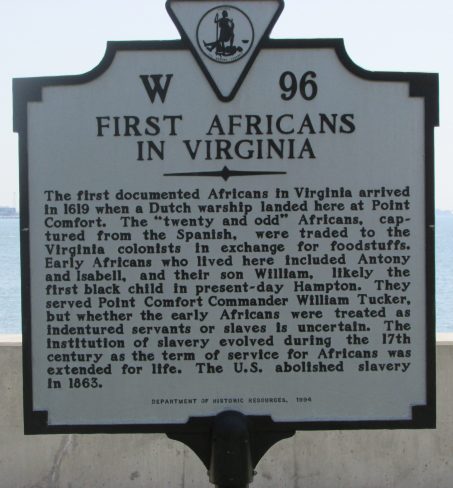Posted on | August 20, 2025 | No Comments

Before we discuss what it means — this date marking a crucial anniversary — let us first recount the relevant facts:
On or about August 20, 1619, “20 and odd” Angolans, kidnapped by the Portuguese, arrive in the British colony of Virginia and are then bought by English colonists. . . .
Founded at Jamestown in 1607, the Virginia Colony was home to about 700 people by 1619. The first enslaved Africans to arrive in Virginia disembarked at Point Comfort, in what is today known as Fort Monroe. . . .
They were originally kidnapped by Portuguese colonial forces, who sent captured members of the native Kongo and Ndongo kingdoms on a forced march to the port of Luanda, the capital of modern-day Angola. From there, they were ordered on the ship San Juan Bautista, which set sail for Veracruz in the colony of New Spain [I.e., Mexico]. As was quite common, about 150 of the 350 captives aboard the ship died during the crossing. Then, as it approached its destination, the ship was attacked by two privateer ships, the White Lion and the Treasurer. Crews from the two ships kidnapped up to 60 of the Bautista’s enslaved people. It was the White Lion which docked at Virginia Colony’s Point Comfort and traded some of the prisoners for food on August 20, 1619.
So, you see, had it not been for the attack by these two English privateer ships, the Portuguese would have taken those African slaves to Mexico, and what would have become of them there? And what might have become of the colonists in Virginia, if the institution of slavery had never been introduced there? These alternatives are seldom discussed by those who, for whatever reason, wish to make the history of slavery an indictment of America and a permanent cause of racial grievance.
What I wish foremost to point out is something that I was taught as a schoolboy, but which our educational institutions recently seem to have forgotten, namely that Virginia, and the other English colonies in North American which later became the United States, was founded in an era of armed rivalry between European powers. For example, my native Georgia was founded in part to defend the southern flank of the Carolinas from the perceived threat of the Spanish presence in Florida.
The Spaniards, the Portuguese, the French, the Dutch — all the maritime powers of Europe had colonies in the New World, and all of them used African slaves as part of their colonial enterprises. The Spaniards had used African slaves on sugar plantations in the Azores, the Canary Islands, and Cape Verde islands. It was in the Spanish colony of Cuba that African slavery was first introduced to the New World, beginning in 1513, and by 1526, the Portuguese were shipping African slaves to Brazil.
From this beginning, the practice spread throughout the Caribbean islands and South and Central America. It was not until 1617, more than 100 years after the Spanish had brought African slavery to Cuba, that the English adopted the institution, when the governor of Bermuda began importing slaves there. All this history is ignored by those who regard the United States as somehow uniquely guilty in regard to slavery.
To explain this would require far more time and effort than I care to devote to the topic today. Readers may have noticed that I never waded into the controversy over the New York Times and its “1619 Project.” Others were outraged, but I bit my tongue rather than to say what was on my mind, namely that it was about damned time liberals finally figured out how much the North was implicated in slavery. For most of my life, Yankees have promoted a libelous myth about the South, popularizing the utterly false belief that somehow Southerners had invented slavery and had a monopoly on it. This is a subject I’ve addressed before (e.g., “History You Probably Never Knew,” December 30, 2023), and readers may recall my ironic amusement a couple of years ago when Revolutionary War hero Gen. Philip Schuyler got “cancelled.”

[T]he 1790 Census found 21,193 slaves in the state of New York, of which 3,722 were in Albany County, “the most of any county in the state at the time.” The Dutch patroons who settled the Hudson River valley were substantially reliant on slave labor and, the 1790 census showed, Philip Schuyler “owned 13 slaves at his South End mansion in 1790 and another four slaves worked on his farm in Saratoga County.”
Insofar as the 1619 Project made people aware that the South did not have a monopoly on slavery, and that Americans who never set foot on a plantation nevertheless derived benefits (directly or indirectly, economically or otherwise) from The Peculiar Institution, then we owe a certain gratitude to Nikole Hannah-Jones. If anyone cares to study the actual history of slavery, I would recommend the late Eugene Genovese’s remarkable Roll, Jordan, Roll: The World the Slaves Made as an introduction. Furthermore, I recommend Robert Fogel and Stanley Engerman’s Time on the Cross: The Economics of American Slavery.
People want us to get angry about stuff that happened 400 years ago, and I ain’t even got time to be angry over what happened last week.
Save on Groceries and Everyday Essentials










